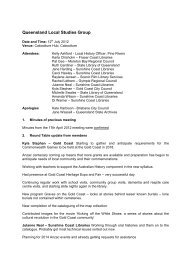Unbound - artists' books from the collection - State Library of ...
Unbound - artists' books from the collection - State Library of ...
Unbound - artists' books from the collection - State Library of ...
Create successful ePaper yourself
Turn your PDF publications into a flip-book with our unique Google optimized e-Paper software.
<strong>Unbound</strong><br />
artists’ <strong>books</strong> <strong>from</strong> <strong>the</strong> <strong>collection</strong>
LINDA NEWBOWN Untitled [Tennis ball] 2001<br />
ink on paper in tennis ball (detail p. 8)<br />
LUKE ROBERTS Untitled 1990<br />
syn<strong>the</strong>tic polymer paint, nails, wax seals, braid and<br />
cloth on commercially printed book<br />
Common <strong>books</strong> look familiar; uncommon <strong>books</strong> do<br />
not. Book art is not synonymous with book design or literary<br />
art; it is something else. 1<br />
Artists’ <strong>books</strong> are <strong>books</strong> or book-like objects created<br />
by artists as works <strong>of</strong> art. They may have text and images,<br />
but <strong>the</strong>n again, <strong>the</strong>y may not. They may be bound as a book<br />
to be opened and perused at leisure, but <strong>the</strong>n again, <strong>the</strong>y<br />
may more resemble sculpture or be nailed firmly shut. They<br />
may follow <strong>the</strong> tradition <strong>of</strong> livres d’artistes, with de luxe<br />
bindings, fine papers and sumptuous plates, or made simply<br />
<strong>from</strong> materials found in <strong>the</strong> environment. There is such a<br />
variety <strong>of</strong> artists’ <strong>books</strong> that it is <strong>of</strong>ten easier to define what<br />
<strong>the</strong>y are not, ra<strong>the</strong>r than what <strong>the</strong>y are: <strong>the</strong>y are nei<strong>the</strong>r<br />
<strong>books</strong> about art, nor do <strong>the</strong>y contain reproductions <strong>of</strong><br />
artists’ works. Artists’ <strong>books</strong> may not even be recognisable<br />
as a book, and <strong>the</strong>se may challenge our conception <strong>of</strong><br />
what constitutes such an object.<br />
The art historian Lucy Lippard suggests that ‘The<br />
artists’ book is a work <strong>of</strong> art on its own, conceived<br />
specifically for <strong>the</strong> book form and <strong>of</strong>ten published by <strong>the</strong><br />
artist him/herself’. 2 Artists’ <strong>books</strong> are conceived and<br />
created as works <strong>of</strong> art; and yet, to fully experience <strong>the</strong>m,<br />
interaction is required. Because <strong>of</strong> this, artists’ <strong>books</strong> may<br />
sit uneasily in an art gallery environment and more<br />
comfortably in a library. Artists’ <strong>books</strong> ideally need to be<br />
held, handled page by page, immersed in and enjoyed in<br />
<strong>the</strong> reader/viewer’s own space – actions in keeping with <strong>the</strong><br />
philosophy <strong>of</strong> a library, but not necessarily <strong>of</strong> an art gallery.<br />
The <strong>State</strong> <strong>Library</strong> <strong>of</strong> Queensland holds approximately<br />
800 artists’ <strong>books</strong> in <strong>the</strong> Australian <strong>Library</strong> <strong>of</strong> Art,<br />
comprising a range <strong>of</strong> creative work <strong>from</strong> private presses<br />
and independent artists working solo or collaboratively,<br />
based within Australia and around <strong>the</strong> world. Thirty artists’<br />
<strong>books</strong> have been selected for <strong>the</strong> Talbot Family Treasures<br />
Wall opening exhibition <strong>Unbound</strong>: artists’ <strong>books</strong> <strong>from</strong> <strong>the</strong><br />
<strong>collection</strong>. While <strong>Unbound</strong> is not an interactive display <strong>of</strong><br />
artists’ <strong>books</strong>, <strong>the</strong> exhibition gives an insight into <strong>the</strong> wealth<br />
<strong>of</strong> treasures held within <strong>the</strong> <strong>State</strong> <strong>Library</strong>, and showcases<br />
some significant holdings by well-known artists.<br />
Part <strong>of</strong> <strong>the</strong> appeal <strong>of</strong> artists’ <strong>books</strong> is <strong>the</strong> distance<br />
<strong>from</strong> well-known conventions that an artist can take a book<br />
without it losing its identity as a book. Book conventions<br />
generally favour <strong>the</strong> bound volume format, as opposed to<br />
o<strong>the</strong>r ways <strong>of</strong> displaying text and image on a page, for<br />
example using scrolls or concertina-fold <strong>books</strong>. In <strong>the</strong><br />
modern western tradition <strong>books</strong> are read <strong>from</strong> left to right,<br />
top to bottom, down <strong>the</strong> left hand page, <strong>the</strong>n on to <strong>the</strong><br />
right. Simple. Not so with artists’ <strong>books</strong> which come in<br />
many shapes, sizes, materials and styles. Some, like Luke<br />
Roberts’ Untitled 1990, simply cannot be opened – it’s<br />
nailed firmly shut. To open <strong>the</strong> book would be to destroy<br />
it as a work <strong>of</strong> art – a tension that Roberts exploits. O<strong>the</strong>r<br />
artists use innovative or overlooked book conventions, such<br />
as <strong>the</strong> concertina folded book, scroll or fan. Some artists<br />
take <strong>the</strong> concept <strong>of</strong> book binding to <strong>the</strong> limits. Linda<br />
Newbown’s Untitled [Tennis ball] 2001 is precisely that:<br />
a book in a tennis ball binding. On <strong>the</strong> first page <strong>the</strong> artist<br />
states ‘This is not a book’ playing on <strong>the</strong> surrealist artist<br />
René Magritte’s semiotic work Ceci n’est pas une pipe<br />
(This is not a pipe) 1928-29 written on his painting which<br />
was unmistakeably <strong>of</strong> a pipe.<br />
Some artists challenge <strong>the</strong> activity <strong>of</strong> reading (where<br />
10/11 <strong>Unbound</strong>: artists’ <strong>books</strong> <strong>from</strong> <strong>the</strong> <strong>collection</strong>
PI O Ockers: a poem 1999<br />
screenprint on paper, in screenprint on cloth-covered<br />
solander box<br />
EDWARD RUSCHA Every building on <strong>the</strong> Sunset Strip 1966<br />
(detail) <strong>of</strong>fset print on paper, in silver reflective paper over card slipcase<br />
ALEX SELENITSCH Australia poet 1989<br />
screenprint and photocopy on card and paper, handmade<br />
paper, candle, string, carborundum in glass vial,<br />
plaster, photocopied booklet in cardboard box<br />
IAN BLAMEY Gomi 1996<br />
<strong>of</strong>fset printing on paper and card, silver paint, acetate<br />
sheet, string, recycled paper held in two-ring binder<br />
bound with pages <strong>from</strong> telephone directory covering<br />
boards and typewriter keys, in Linguaphone case<br />
<strong>the</strong> usual state is silence and stillness) by making reading a<br />
physical activity, requiring unfolding, turning, reading across<br />
angles, or along a length <strong>of</strong> paper. Ed Ruscha’s Every<br />
building on <strong>the</strong> Sunset Strip 1966 requires <strong>the</strong> text and<br />
images to be read along <strong>the</strong> top <strong>of</strong> <strong>the</strong> seven metre book<br />
<strong>from</strong> left to right, <strong>the</strong>n along <strong>the</strong> bottom <strong>from</strong> right to left, as<br />
if you are travelling down one side <strong>of</strong> Sunset Boulevard, <strong>the</strong>n<br />
<strong>the</strong> o<strong>the</strong>r, looking at <strong>the</strong> buildings in a way which imitates<br />
Ruscha’s process in making <strong>the</strong> book. Every building on<br />
<strong>the</strong> Sunset Strip was produced in several editions, and <strong>the</strong><br />
<strong>State</strong> <strong>Library</strong>’s copy is <strong>from</strong> <strong>the</strong> first edition. It is a pivotal<br />
work <strong>from</strong> <strong>the</strong> 1960s pop art movement, its deadpan style<br />
and production as a multiple defying <strong>the</strong> artistic convention<br />
<strong>of</strong> <strong>the</strong> single, unique object that sells for high prices in a<br />
commercial gallery.<br />
Clive Phillpot, discussing contemporary artists and <strong>the</strong>ir<br />
<strong>books</strong>, suggested that with Ruscha’s artists’ <strong>books</strong>, ‘The<br />
customary aura <strong>of</strong> artworks was instantly dispelled. There<br />
were no precious objects to be locked away and protected<br />
<strong>from</strong> inquisitive viewers. They were obviously for use, and<br />
intended to be handled and enjoyed’. 3 Thus, Ruscha<br />
created <strong>the</strong> paradigm for artists’ <strong>books</strong> as something<br />
distinct <strong>from</strong> existing artistic practice, but strongly related<br />
to it, and <strong>of</strong>ten critical <strong>of</strong> it.<br />
The boldness <strong>of</strong> 1960s pop sensibility is also<br />
expressed in Australian performance poet Pi O’s Ockers<br />
1999, a retrospective look into <strong>the</strong> world <strong>of</strong> 1970s culture<br />
and machismo habits. Ockers was conceived, designed<br />
and illustrated with linocuts by Mike Hudson and hand set<br />
by Jadwiga Jarvis <strong>of</strong> Wayzgoose Press. It displays a graphic<br />
style characteristic <strong>of</strong> comic <strong>books</strong> made familiar by <strong>the</strong><br />
work <strong>of</strong> American pop artist Roy Lichtenstein. Humour is<br />
an important aspect <strong>of</strong> this work, and is an element shared<br />
with several o<strong>the</strong>r artists in <strong>Unbound</strong>. Ian Blamey and Alex<br />
Selenitsch bring Dada-esque and Fluxus inspired wit to<br />
<strong>the</strong>ir works GOMI 1996 and Australia poet 1989, with <strong>the</strong>ir<br />
unpredictable use <strong>of</strong> materials, font styles and an element<br />
<strong>of</strong> surprise. Fluxus artist Dick Higgins spoke <strong>of</strong> <strong>books</strong><br />
existing between media, not specific to any particular art<br />
form, but stressing <strong>the</strong> interplay between <strong>the</strong>m: ‘This is <strong>the</strong><br />
intermedial approach, to emphasize <strong>the</strong> dialectic between<br />
<strong>the</strong> media’. 4 Each page <strong>of</strong> Blamey’s and Selenitsch’s works<br />
promises a different experience that requires different reading<br />
processes, whe<strong>the</strong>r through <strong>the</strong> unusual combination <strong>of</strong><br />
images, <strong>the</strong> way <strong>the</strong>y are presented, relation to text or, with<br />
Selenitsch, through his collaborator’s contributions.<br />
While laughing out loud is permitted – even encouraged<br />
– when looking at some artists’ <strong>books</strong>, an assault on<br />
reading in silence can be made by <strong>the</strong> <strong>books</strong> <strong>the</strong>mselves.<br />
Artists’ <strong>books</strong> can be surprisingly noisy to read, making<br />
sounds as <strong>the</strong> pages are turned, or <strong>the</strong> text is revealed.<br />
No matter how careful <strong>the</strong> reader is, Sebastian Di Mauro’s<br />
Leaves <strong>of</strong> stone 1991 makes sharp scraping noises as<br />
<strong>the</strong> leaves are turned and come to rest on each o<strong>the</strong>r,<br />
and bumping noises as <strong>the</strong>y touch <strong>the</strong> cradle, which is<br />
unnerving to readers accustomed to <strong>the</strong> silent<br />
contemplation <strong>of</strong> image or text.<br />
Jan Hogan’s Little Red Riding Hood 1992 can be seen<br />
simultaneously as an interactive game and an aes<strong>the</strong>tic<br />
object, pointing to a double bind implicit in many artists’<br />
<strong>books</strong>: if used as intended, <strong>the</strong>y risk being destroyed by <strong>the</strong><br />
very act that makes <strong>the</strong>m different <strong>from</strong> both art and <strong>books</strong>.<br />
12/13 <strong>Unbound</strong>: artists’ <strong>books</strong> <strong>from</strong> <strong>the</strong> <strong>collection</strong>
SEBASTIAN DI MAURO Leaves <strong>of</strong> stone 1991<br />
(detail Air) engraved slate in wooden cradle<br />
JAN HOGAN Little Red Riding Hood 1992<br />
lithograph on paper on wood, in hinged wooden case<br />
ROY FISHER AND RONALD KING<br />
Anansi Company 1992<br />
screenprint and hand stencil on Arches<br />
paper and card, letterpress on paper, wire,<br />
in screenprinted cloth-covered solander box<br />
14/15 <strong>Unbound</strong>: artists’ <strong>books</strong> <strong>from</strong> <strong>the</strong> <strong>collection</strong>
EDWARD LEAR The owl and <strong>the</strong> pussycat 1988<br />
illustrated by Andrew Sibley<br />
pochoir print and hand illumination on paper in lea<strong>the</strong>r<br />
and suede binding with inlaid colour vellum panel<br />
BERNADETTE CROCKFORD<br />
Concrete poetry 1996<br />
intaglio print on paper in cloth-covered<br />
boards, ribbon<br />
This forces us to make a choice between seeing <strong>the</strong> work<br />
as art (contemplation), text (reading) or play (interaction).<br />
The fabulously colourful Anansi Company 1990, created<br />
by <strong>the</strong> artist Ronald King and poet Roy Fisher was made in<br />
celebration <strong>of</strong> <strong>the</strong> Caribbean community in Notting Hill, and<br />
intended to be used as puppets – each <strong>of</strong> <strong>the</strong> wire fi gures<br />
can be removed to perform <strong>the</strong> story. Like <strong>the</strong> costumes<br />
and props in Carnivale, or <strong>the</strong> ephemera produced for a<br />
performance, Anansi Company comments on <strong>the</strong> tension<br />
between our love <strong>of</strong> collecting for posterity and <strong>the</strong> joy <strong>of</strong><br />
using something for <strong>the</strong> moment.<br />
Play, interaction and movement disrupts our common<br />
experience <strong>of</strong> reading, as does non-linear text. Bernadette<br />
Crockford’s Concrete poetry 1996, with its origami-like<br />
folds, opens like a fl ower to reveal text that follows <strong>the</strong> paper<br />
creases. The reader must turn <strong>the</strong> book to read, playing with<br />
different combinations <strong>of</strong> sentences along different folds,<br />
and making up a different poem each time <strong>the</strong> book is read.<br />
The fi nal section <strong>of</strong> works pays homage to <strong>the</strong> tradition<br />
<strong>of</strong> livres d’artistes, developed at <strong>the</strong> end <strong>of</strong> <strong>the</strong> nineteenth<br />
century by French art dealers and publishers who wished<br />
to combine classic text with illustrations by artists <strong>of</strong> <strong>the</strong> day.<br />
In livres d’artistes text follows convention, and images relate<br />
to <strong>the</strong> text. The earliest livre d’artiste on display follows this<br />
tradition, in Charles Baudelaire’s text Les fl eurs du mal 1947,<br />
with accompanying illustrations by Henri Matisse.<br />
While not strictly artists’ <strong>books</strong>, livres d’artistes have<br />
proved popular with contemporary artists who want <strong>the</strong> look<br />
and feel <strong>of</strong> an objet de luxe. This tradition can also be used<br />
in a subversive manner, where <strong>the</strong> content and style<br />
combine to comment on <strong>the</strong> way we perceive <strong>books</strong> and<br />
reading. Andrew Sibley’s The owl and <strong>the</strong> pussycat 1988 –<br />
a poem familiar to many – refl ects on <strong>the</strong> oral tradition <strong>of</strong><br />
conveying information that existed prior to <strong>the</strong> invention<br />
<strong>of</strong> <strong>books</strong>. Udo Sellbach, referencing Goya’s series <strong>of</strong> prints<br />
Desastres de la guerra (Disasters <strong>of</strong> war) <strong>of</strong> 1808, uses<br />
beautiful paper, binding and exquisite printmaking<br />
techniques showing us that, just as in Goya’s time, atrocities<br />
are still commonplace. In a similar vein, Raymond Arnold’s<br />
volume History/Memory 1999 contemplates <strong>the</strong> artist’s<br />
own relationship with <strong>the</strong> battlefi elds <strong>of</strong> Europe where his<br />
ancestors fought. Trained as a printmaker, Arnold uses<br />
digital technology to render his images in book form.<br />
Recent developments in technology have made it<br />
possible for artists to publish <strong>from</strong> <strong>the</strong>ir desktops, an<br />
innovation as revolutionary as <strong>the</strong> invention <strong>of</strong> <strong>the</strong> printing<br />
press in <strong>the</strong> fi fteenth century. Such an important shift in <strong>the</strong><br />
dynamics <strong>of</strong> printing was recognised when Jan Davis won<br />
<strong>the</strong> Fremantle Print Prize in 1995 with Solomon c 1995,<br />
a captivating and enigmatic series <strong>of</strong> seven volumes that<br />
presents a complex array <strong>of</strong> images based on <strong>the</strong> Pacifi c<br />
Ocean islands visited by <strong>the</strong> artist.<br />
The choice to feature artists’ <strong>books</strong> as <strong>the</strong> inaugural<br />
display <strong>of</strong> <strong>the</strong> Talbot Family Treasures Wall was, in <strong>the</strong> end,<br />
obvious: it refl ected in a challenging and thought-provoking<br />
way <strong>the</strong> long tradition <strong>of</strong> enquiry, curiosity and innovation<br />
that <strong>books</strong> signify – particularly in <strong>the</strong> hands <strong>of</strong> artists. It<br />
also focussed on one <strong>of</strong> <strong>the</strong> strengths <strong>of</strong> <strong>the</strong> <strong>State</strong> <strong>Library</strong>’s<br />
<strong>collection</strong>, as well as providing a link between art and text.<br />
Like <strong>the</strong> refurbished <strong>State</strong> <strong>Library</strong>, <strong>the</strong>se artists’ <strong>books</strong><br />
represent vitality, creativity and relevance, recognising a link<br />
to <strong>the</strong> past, but with aspirations for a stimulating future.<br />
1. Kostelanetz, R 1987, ‘Book Art’, in J Lyons (ed), in Artists’ <strong>books</strong>: a critical anthology<br />
and source book, Peregrine Smith Books, Utah, USA, p. 27.<br />
2. Lippard, L 1987, ‘The Artist’s Book Goes Public’, in J Lyons (ed), Artists’ <strong>books</strong>: a<br />
critical anthology and source book, Peregrine Smith Books, Utah, USA, p. 45.<br />
3. Phillpot, C 1987, ‘Some Contemporary Artists and Their Books’, in J Lyons (ed), Artists’<br />
<strong>books</strong>: a critical anthology and source book, Peregrine Smith Books, Utah, USA, p. 97.<br />
4. Higgins, D 1967, in W Vostell (ed), Dé-coll/age (décollage) * 6, Typos Verlag, Frankfurt,<br />
Something Else Press, New York.<br />
<strong>Unbound</strong>: artists’ <strong>books</strong> <strong>from</strong> <strong>the</strong> <strong>collection</strong> on display<br />
25 November 2006 – 11 March 2007<br />
16/17 <strong>Unbound</strong>: artists’ <strong>books</strong> <strong>from</strong> <strong>the</strong> <strong>collection</strong>
UDO SELLBACH And still I see it 1995<br />
(detail) etching, aquatint and letterpress on paper in<br />
fabric over board binding, in fabric-bound slipcase,<br />
in acetate wrapper<br />
RAYMOND ARNOLD Memory/history 1999<br />
digital print and letterpress on paper in cloth-bound screwpost<br />
binding with inlaid digital print in matching slipcase<br />
JAN DAVIS Solomon c 1995<br />
digital print on paper in cloth over board binding in<br />
matching slipcase<br />
18/19 <strong>Unbound</strong>: artists’ <strong>books</strong> <strong>from</strong> <strong>the</strong> <strong>collection</strong>


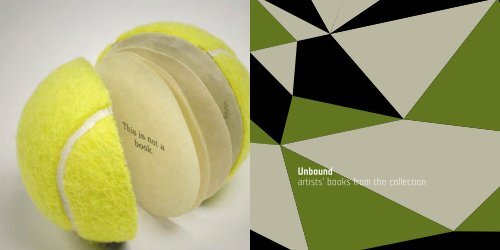
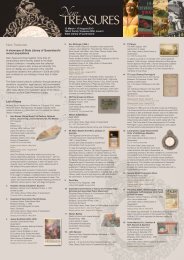
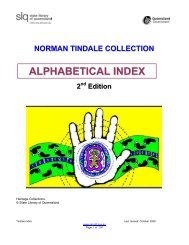


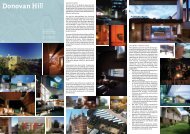
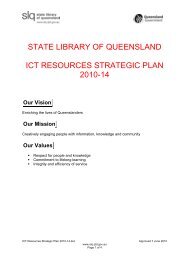
![2009-10 [ 13 MB] - State Library of Queensland - Queensland ...](https://img.yumpu.com/26312803/1/184x260/2009-10-13-mb-state-library-of-queensland-queensland-.jpg?quality=85)
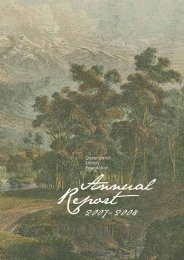
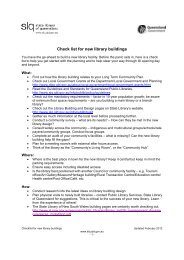
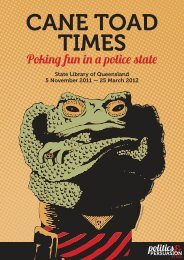
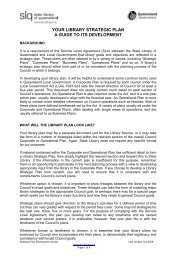
![2011-12 Part 4 [PDF 3.0 MB] - State Library of Queensland](https://img.yumpu.com/26312768/1/190x135/2011-12-part-4-pdf-30-mb-state-library-of-queensland.jpg?quality=85)
![Full room brochure [ (PDF 1.3 MB)] - State Library of Queensland](https://img.yumpu.com/26312762/1/190x101/full-room-brochure-pdf-13-mb-state-library-of-queensland.jpg?quality=85)
